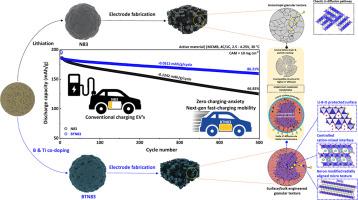A heuristic strategy for converting Ni-rich hydroxide precursors into sustainable fast-charging cathodes for next-generation lithium-ion batteries
IF 20.2
1区 材料科学
Q1 CHEMISTRY, PHYSICAL
引用次数: 0
Abstract
Ni-rich R-3m polycrystalline layered oxides (LiNi1-xMxO2; M = Mn, Co, Ti; 0 ≤ x ≤ 0.2) are among the most promising Li-ion battery cathodes, combining high energy density with cost-effective production. However, their fast-charging capability is hampered at high voltages due to sluggish Li+ transport and structural degradation. Herein, we report a heuristic, solid-state co-doping strategy employing boron (B3+) and titanium (Ti4+) to simultaneously engineer the bulk structure and surface chemistry of Ni-rich cathodes. The co-doped materials demonstrate exceptional stability in lithium-graphite full cells, retaining >86% capacity after 500 cycles at a 4C charge rate, even across elevated cutoff voltages (4.3-4.5 V) and high Ni contents (80–100 mol%). Multiscale characterization reveals three critical morphological features: (i) radially arranged nanosheet-like grains that alleviate anisotropic lattice strain; (ii) an in-situ formed Li-B-O surface layer that mitigates electrolyte decomposition at high voltage; and (iii) a defect-mediated cation-mixed interphase that pillars the layered structure under extreme delithiation. Extension of this strategy to ultra-high Ni systems, including LiNi0.9Co0.1O2 and LiNiO2, yielded comparable enhancements. Mechanistic insights further enabled the rational selection of earth-abundant pillaring elements, enhancing the scalability and sustainability of the proposed doping system. This work underscores the potential of defect phase engineering and microstructural control without reliance on group V/VI dopants for the development of robust, fast-charging Ni-rich cathodes.

将富镍氢氧化物前体转化为下一代锂离子电池可持续快速充电阴极的启发式策略
富镍的R-3m多晶层状氧化物(LiNi1-xMxO2; M = Mn, Co, Ti; 0≤x≤0.2)是最有前途的锂离子电池阴极之一,结合…
本文章由计算机程序翻译,如有差异,请以英文原文为准。
求助全文
约1分钟内获得全文
求助全文
来源期刊

Energy Storage Materials
Materials Science-General Materials Science
CiteScore
33.00
自引率
5.90%
发文量
652
审稿时长
27 days
期刊介绍:
Energy Storage Materials is a global interdisciplinary journal dedicated to sharing scientific and technological advancements in materials and devices for advanced energy storage and related energy conversion, such as in metal-O2 batteries. The journal features comprehensive research articles, including full papers and short communications, as well as authoritative feature articles and reviews by leading experts in the field.
Energy Storage Materials covers a wide range of topics, including the synthesis, fabrication, structure, properties, performance, and technological applications of energy storage materials. Additionally, the journal explores strategies, policies, and developments in the field of energy storage materials and devices for sustainable energy.
Published papers are selected based on their scientific and technological significance, their ability to provide valuable new knowledge, and their relevance to the international research community.
 求助内容:
求助内容: 应助结果提醒方式:
应助结果提醒方式:


